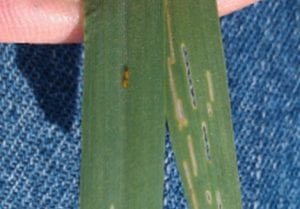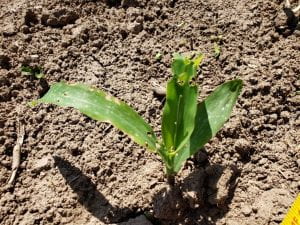Alfalfa Weevil Larvae Over Threshold
The warmer stretch of weather has really brought on the alfalfa weevil larvae! We have seen and received reports of many fields at or above threshold. Treatment threshold on first cut is if 40% of the stems have tip-feeding injury (see picture). Randomly pick 50 stems and count the number with feeding damage. You do not have to actually look for the larvae. If 20 of those 50 stems are positive for damage, you are at 40%. The key is to cut before the AW larvae reach the 4th instar. This stage causes 80% of the feeding damage. I was finding mostly 2nd instar larvae this week. The NWNY Team has a short YouTube video on how to scout for AW feeding injury and determine if the field is over threshold. Hopefully, we can get some of this alfalfa harvested before injury becomes economic.

Cereal Leaf Beetles Laying Eggs

It was easy to find Cereal Leaf Beetle (CLB) eggs in most wheat fields I have been visiting this week. CLB eggs are orange and usually laid down the midrib of the leaf. There could be just one egg or several in a chain. It was also easy to see leaf feeding from adults (see picture). Most of these eggs look new and I did not see any close to hatching. Threshold is three eggs and larvae per plant or one larva per flag leaf. Make sure to scout your oats as you may have an opportunity to add an insecticide to your herbicide application if needed.
Black Cutworm and Armyworm Update

Black cutworm moths continue to be active across our region. The storms over the week brought in a whole new batch of significant flights. Most areas gained about 100 DD over the past week. Eggs from our first significant flight on April 27 should have hatched now. Some areas are about halfway to the 300 DD needed for larvae to be large enough to cut corn plants. We may start to see some early leaf feeding next week. Armyworm flights have been pretty low across the region but they are still here.


- Egg hatch around 90 Degree Days
- Plant cutting around 300 Degree Days
- Degree Day data from Network for Environment and Weather Applications, NEWA
Winter Wheat Update: Flag Leaf Emerging
Most of the early planted wheat had the flag leaf fully emerged (Feekes stage 9) this week. Later planted fields had the flag leaf just peaking out (Feekes stage 8). This means that herbicides such as Harmony Extra should not be applied anymore. I know that some nitrogen (second shot) is still being applied. The hot dry weather really pushed the plants along. I am not seeing any powdery mildew in the lower canopy but could be present in thick fields with higher tiller counts particularly with the string of showers predicted. Heads will be in the boot soon!
Summary of Alfalfa Height and Prediction of % NDF- May 19, 2022
Height indicators of alfalfa and grass for NDF content are below:
- In general, we say 100% grass stands should be cut when nearby alfalfa is 14 inches tall to achieve the desired 50% NDF.
- Begin cutting 50/50 mixed alfalfa and grass stands when nearby alfalfa is 22 inches tall for the desired 44% NDF.
- Begin cutting 100% alfalfa stands when alfalfa is 28 inches tall for desired 40% NDF.
As of today, May 19, 2022 alfalfa heights varied between 19-23 inches across locations. First cutting of grasses has begun, to be followed by mixed stands around May 21st and pure alfalfa at the end of May/beginning of June.
Remember, timely harvests optimize production and quality while removing the crop when soil moisture and rainfall are prevalent, which helps regrowth. Late first-cutting harvest reduces quality and increases the likelihood that soil moisture and potential lack of rain will impede regrowth. Optimizing first cutting can help regulate forage digestibility, maximize forage usage in the diet, and counteract inflated commodity costs.




